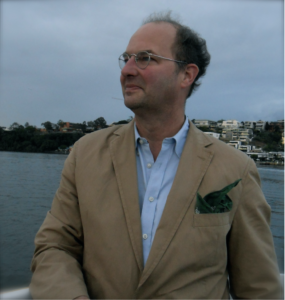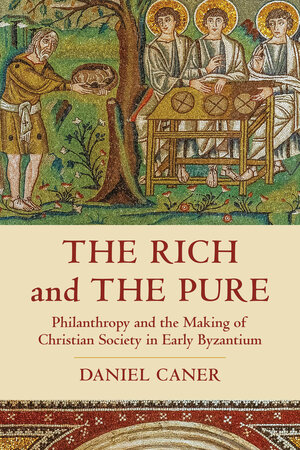Daniel Caner, author of the new book The Rich and The Pure joined us to discuss some of the key findings from his work.

As the Roman Empire broke down in western Europe, its prosperity moved decisively eastward, to what is now known as the Byzantine Empire. Here was born history’s first truly affluent, multifaceted Christian society. One of the ideals used to unite the diverse millions of people living in this vast realm was the Christianized ideal of philanthrōpia. In this sweeping cultural and social history, Daniel Caner shows how philanthropy required living up to Jesus’s injunction to “Give to all who ask of you,” by offering mercy and/or material aid to every human being, regardless of their origin or status. Caner shows how Christian philanthropy became articulated through distinct religious ideals of giving that helped define proper social relations among the rich, the poor, and “the pure” (Christian holy people), resulting in new and enduring social expectations. In tracking the evolution of Christian giving over three centuries, he brings to the fore the concerns of the peoples of Early Byzantium, from the countryside to the lower levels of urban society to the imperial elites, as well as the hierarchical relationships that arose among them. The Rich and the Pure offers nothing less than a portrait of the whole of early Byzantine society.
Daniel Caner is Associate Professor at Indiana University, Bloomington. His previous books include Wandering Begging Monks: Spiritual Authority and the Promotion of Monasticism in Late Antiquity and History and Hagiography from the Late Antique Sinai.
How did you become interested in this topic?
As a social historian and a classicist, I was drawn to studying the transition from the classical to the medieval worlds while living in Greece in the 1980s. There I met monks, who made me interested in this relatively foreign aspect of Christianity and its historical roots in ancient society.
I began thinking about the issues surrounding wealth, monks and philanthropy discussed in The Rich and The Pureafter writing an earlier book about radical early monastic notions of poverty and the challenge these posed to church leaders and their promotion of monasticism in the ancient world. I found other authors frequently referring to a material gift called a eulogia, or blessing. Subsequent research revealed that this was something different from what I already knew about a gift of alms. It opened a whole world of gift-giving ideals and practices that led to much larger questions about religious wealth and philanthropy in history’s first truly complex Christian society.
What does gift-giving show us about the social dynamics of early Christian society?
It shows us a great deal about the social assumptions, concerns and priorities of the people who wrote our sources. Gift-giving is ultimately always about human relationships – about establishing, defining, perpetuating, or in some cases ending a set of relationships and responsibilities. Whenever our ancient church or monastic leaders wrote about specific religious gifts—whether as gifts or acts of philanthropy, alms, charity, blessing, or offering—they were writing about the enactment of certain ideal relationships within their society—between rich and poor people, between secular and “holy” people, or between humans and the divine.
Such gift-giving was ultimately meant to uphold the aristocratic secular and religious hierarchies that prevailed in this complex Christian world. It was certainly not our modern secular world, with its notions of freedom, equality or democracy. But it was one that both promoted and, I argue, sought to regularly practice various forms of altruism and enlightened self-interest. It expected all its participants, without exception, to help ameliorate the circumstances of others, regardless of whether they had done anything to deserve it.
This was the universal challenge posed by ancient Christian philanthropy, and one that was genuinely alive in the fourth, fifth and sixth centuries. It prompted Christian authorities to come up with the means of preparing themselves and others to fulfill the ideal with compassion. Monasteries proved to be training grounds in the acquisition of such compassion. The seemingly odd result was that monks came to be regarded as the public exemplars of compassionate philanthropy, mercy or charity for church leaders as well as lay society.
How does your book change our understandings of Christian wealth?
Unlike other books nominally dealing with Christian wealth, mine seeks to explain exactly what Christian wealth was supposed to be, and what distinguished good or sacred wealth from ordinary or sinful accumulation. I describe how such wealth was imagined to be generated by God for circulation and support of humanity, or obtained by various types of “just” gain, or created by holy people through several different levels of gift-giving that distanced and refined whatever was given or received from its possibly sinful origins.
What I add that is really new is how positive notions of wealth were envisioned and promoted by early monastic authorities themselves. This emphasis comes partly out of necessity: anyone who wishes to understand early Christian notions of wealth under the late Roman Empire must face the fact that most of our sources after the fourth century were written about “holy people” or from a monastic perspective—so-called ‘hagiography’. This partly reflects that fact that many monastic communities were themselves becoming wealthy. Secular historians like myself have traditionally treated evidence for monastic wealth mainly as obvious evidence of monastic hypocrisy or corruption. But these sources raise fascinating questions about how early Christian ascetics negotiated concerns about their own receipt of patronal gifts as well as the expectation that monks would “give to all who asked of them,” while not possessing any personal property.
As I explain, the solutions found in these sources included not only setting various priorities in giving (e.g., giving to all, but not in the same amount or degree), but also in elevating certain gifts that might be considered paltry by ordinary standards. Thus a gift of charity was viewed as a gift given of one’s essential resources—meaning possibly one’s own soul for want of any material possession. A gift known as a blessing was viewed as something derived from one’s God-given excess resources, although it was often simply one’s scraps or leftovers. These ascetic conceptualizations were then used to define other types of wealth, resources, and the gifts or expectations derived from them.
What was something surprising or unexpected that you discovered over the course of your research?
One of the great experiences of this book for me was how much I came to learn that I hadn’t expected when I started. Each new effort of research or writing made me realize aims, facets and dimensions of the gifts in question that I hadn’t appreciated before, as well as the full complexity of the social or religious concerns that lay beneath them.
But especially thrilling was my discovery of a gift ideal of charity. That hadn’t been part of my original project at all. I discovered it while I was trying to find evidence for almsgiving within monastic communities and between individual monks, but only found references to charity (agapē, rhem). Once I paid attention to this, I realized that a distinct set of practices, material resources and notions of self-sacrifice were related to this particular gift ideal that were not found in discussions about alms, blessings or other gifts. I felt like I had struck gold by accident, and that I had grown a little as a result.
What is the main message you hope readers will take away from your book?
I hope readers will appreciate how complex this ancient Christian society was, and how new gift-giving ideals laid the basis for shaping relations between ordinary Christians, its religious and its spiritual leaders. What is remarkable is that it invented a coherent set of gift ideals that not only expressed core communal values like philanthropy, charity, and mercy, but also sought to meet material and spiritual needs, like those of food, redemption and remembrance.
